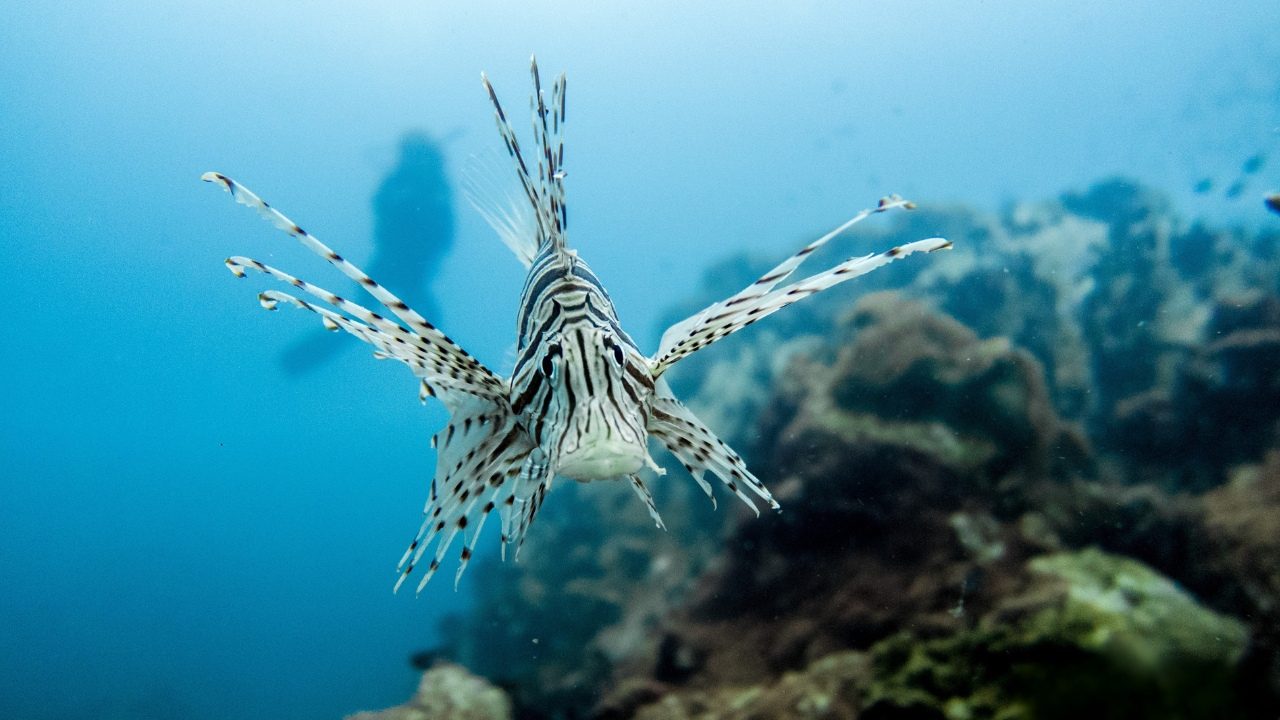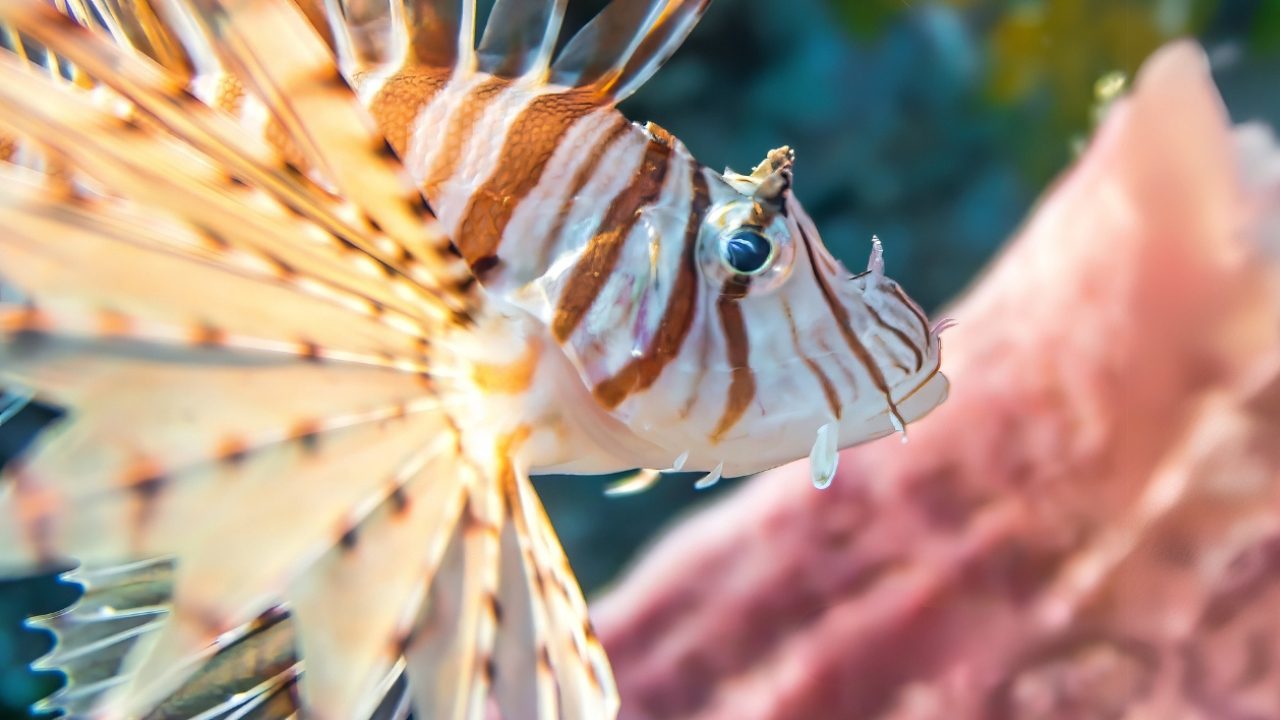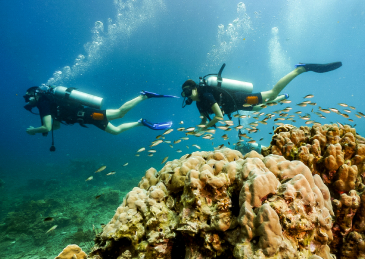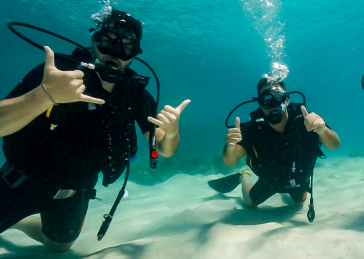Modified 9th June 2025
Lionfish Koh Tao: Complete Guide to Spotting These Magnificent Predators
Among the diverse marine life inhabiting Koh Tao’s underwater realm, few creatures command the same level of respect and fascination as the lionfish. While not commonly encountered compared to other reef species, these magnificent predators with their distinctive fan-like fins create unforgettable moments for fortunate divers. Their relative scarcity makes each sighting precious – a true underwater treasure that highlights the exceptional biodiversity of Thailand’s premier diving destination.

The primary species encountered in Koh Tao’s waters is the Red Lionfish (Pterois volitans), instantly recognizable by its striking appearance and elaborate fin structures. These remarkable fish represent one of nature’s most beautiful yet dangerous marine predators, combining stunning visual appeal with potent defensive capabilities.
Visual Identification and Physical Characteristics
| Feature | Description |
|---|---|
| Scientific Name | Pterois volitans (Red Lionfish) |
| Size | Up to 30 cm (12 inches) in length |
| Coloration | Maroon to reddish-brown body with white/cream bands |
| Distinctive Features | Up to 18 fan-shaped pectoral fins with venomous dorsal spines |
| Movement | Graceful, resembling a ballet dancer’s poise |
| Best Observation Times | Dawn/dusk or during night dives when they’re more active |
Red Lionfish typically reach about 30 centimeters in length when fully mature, creating an imposing presence despite their modest size. Their most distinctive feature – the elaborate array of fins – serves multiple purposes beyond aesthetics. The dorsal, anal, and pelvic fins contain venomous spines providing effective defense against potential predators.
Their bold coloration serves as aposematic warning to other marine creatures, signaling potential danger through nature’s universal language of bright colors and patterns. Beyond defensive adaptations, lionfish possess large mouths capable of rapid expansion to engulf prey whole, combined with excellent eyesight for precision hunting.
Behavior and Hunting Techniques
Lionfish exhibit fascinating behavioral patterns reflecting their predatory nature. During daylight hours, they seek shelter in crevices, caves, and under rock formations, becoming active during twilight and nighttime when they emerge to hunt. Their movement is often described as ballet-like – graceful and deliberate, with elaborate fins creating hypnotic flowing effects.
As ambush predators, lionfish employ unique hunting strategies. They slowly stalk prey, using large pectoral fins to corner smaller fish against reef structures. Once positioned, they strike with remarkable speed, creating powerful suction with their mouth that draws in prey up to half their own size.

While generally not aggressive toward divers, lionfish adopt defensive postures when threatened. They turn to face perceived threats, spread fins to appear larger, and point venomous spines outward. If cornered without escape routes, they can charge with surprising speed – not to attack, but to create opportunities to flee.
Prime Lionfish Spotting Locations in Koh Tao
Night dives at these locations significantly increase chances of spotting active lionfish, as this is when they emerge from daytime hiding spots to hunt. Experienced local guides knowing specific crevices and overhangs where lionfish regularly shelter can dramatically improve encounter opportunities. Understanding the best diving conditions and seasons can also enhance your chances of marine life encounters.
Safety Precautions and Venom Awareness
Lionfish beauty comes with serious danger – their dorsal, anal, and pelvic spines contain potent venom serving as primary defense mechanisms. While not typically aggressive toward divers, accidental contact can result in extremely painful stings causing swelling, nausea, and severe symptoms.
- Maintain respectful distance: Stay at least arm’s length away from any lionfish encountered
- Practice buoyancy control: Prevent accidental contact, especially in areas with currents
- Exercise caution in crevices: Take extra care examining caves and overhangs where lionfish shelter
- Recognize warning signs: If lionfish faces you directly and spreads fins, give immediate space
- Know sting treatment: Immerse affected area in hot water (45°C) for 30-90 minutes
- Seek medical attention: Always consult medical professionals after any lionfish encounter
Despite their venomous nature, lionfish pose minimal threat to divers observing proper diving etiquette and maintaining environmental awareness. Their venom is defensive, not used for hunting or human aggression.
Ecological Role and Conservation Status
While lionfish have become notorious invasive species in Caribbean and Western Atlantic waters, they exist in natural balance within their native Indo-Pacific range around Koh Tao. Here, they serve as mid-level predators helping control populations of smaller reef fish and crustaceans.
Their presence in healthy numbers indicates balanced ecosystems, as they have natural predators keeping populations in check, including larger groupers, moray eels, and sharks. The relative scarcity around Koh Tao compared to other marine species may be attributed to natural predation, specific habitat preferences, and regional population distributions. Learn more about marine conservation efforts in Koh Tao and how divers can contribute to protecting these ecosystems.
Unlike Caribbean waters where lionfish hunting is encouraged to control invasive populations, in native Thai waters lionfish should be appreciated as natural and valuable ecosystem components. Observe respectfully without disturbing these magnificent creatures. Discover more about responsible marine life observation practices.
Photography Tips for Lionfish Encounters
Join La Bombona Diving for your best chance of encountering these magnificent predators!
Our experienced dive guides know the exact locations and optimal times for lionfish sightings around Koh Tao. With expert knowledge of local marine life behavior and prime dive sites, we maximize your chances of witnessing these spectacular creatures in their natural habitat.
- Expert guides with extensive lionfish spotting experience
- Access to prime dive sites including HTMS Sattakut wreck
- Night dive options for optimal lionfish activity
- Safe diving practices around venomous marine life
- Small group sizes for personalized attention
- Professional marine life identification assistance
- Photography guidance for perfect lionfish shots
- Comprehensive safety briefings and protocols
Fun Dive Package: ฿2,000 – 2 dives with expert marine life guides
Book Your Lionfish Adventure4 hours AM or PM dive sessions | All equipment included | Expert marine life spotting
Frequently Asked Questions About Lionfish Koh Tao
For divers exploring Koh Tao’s underwater realm, encountering lionfish represents those special moments highlighting extraordinary marine diversity and beauty. Despite relative scarcity compared to other species, their unmistakable appearance and graceful movement create memorable underwater experiences. By understanding behavior, habitat preferences, and practicing responsible diving around these magnificent creatures, visitors can appreciate one of the ocean’s most distinctive and fascinating residents.
Bucea con LBD: tu puerta a la exploración submarina
Whether you’re a curious beginner or a seasoned pro, our school is your portal to the wonders of scuba diving. Join us into the world beneath the waves.
¿LISTO PARA EMPEZAR?
Consulta nuestros cursos de buceo en Koh Tao



